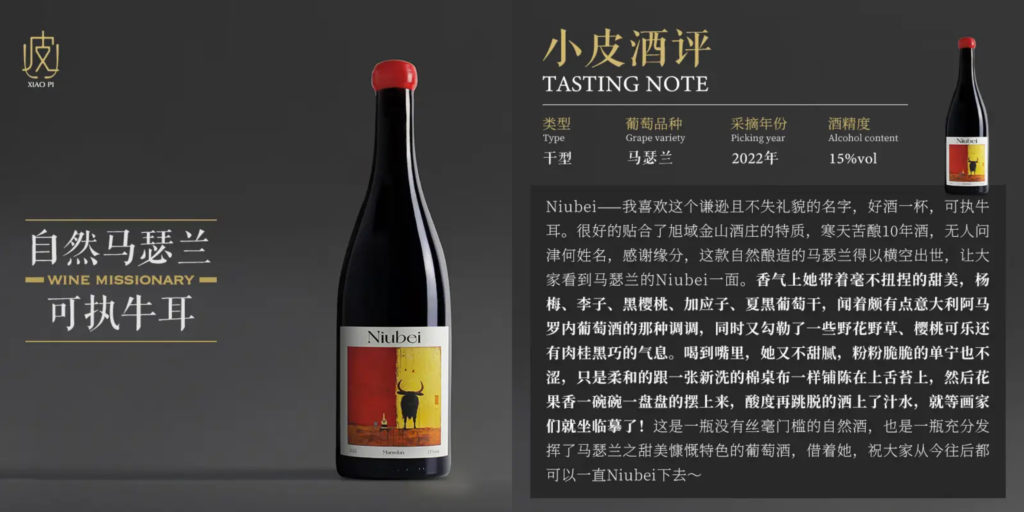
Yesterday, I posted a list of ten Chinese wines you could buy for the same price — RMB2450 / US$335 — as one bottle of Lafite’s new flagship wine from its Longdai winery in Shandong.
I created the list at the jd.com shop of Terry Xu aka Xiao Pi, a wine critic known for making fun and easy to understand tasting notes.
I then made a second list, with ten “hipster” wines, including pet-nats, orange wines, rare grape varieties and more, following the same rule — they had to cost no more than the price of that Longdai bottle.
Check out the hipster list below. And the classic list at this link.

Lingering Clouds Muscat Pet-Nat
RMB198 / USD28
Floral, fruity, fresh. This rose is one of a number of pet-nats created by Jianjun ‘Johnny’ Liu during the past few years, even as the COVID crisis raged.
Liu also made three tea-infused Chardonnays pet-nats: oolong, jasmine and Longjing. We opened a 2021 oolong last week and two people at our table rated it best wine out of nine. It’s becoming more aromatic and complex with age.

FARMentation ‘Rose’ Orange
RMB188 / USD26
Created by winemaker Luo Yuchen based on a winery, and label, from Shaanxi in 1911. The grape: Black Muscat.
This is an intriguing mix of acidity and tannins, with all manner of aromas popping up: dried fruit, cloves, honey, a hint of something like hawthorn or yangmei.
I first tried this at Wine to Asia in Shenzhen this year, at the YGC — Young Winemakers China — pavilion, and hope to taste it again soon.
I also included it because I like the story: this is first in a series of “revival” wines Luo is making to pay tribute to China’s oenological past.

Puchang ‘Orange’ Rkatsiteli
RMB348 / USD49
My favorite new Chinese orange wine of 2023. Sixty days of skin contact, fermentation via wild yeast, no sulfur added nor filtration before bottling. And as best I know, the only such wine made in China with the grape Rkatsiteli, native to Georgia.
A delectable combination of fruit, acidity and tannins. Smells like a fruit shop, with tangerine, passionfruit, mango and more. Pleasing texture and weight, with lots of citrus character–I’m thinking tangerine and grapefruit–and hints of vanilla, nuts and dry grass. I decided to enjoy this bottle a week and found it still drinking well on day seven.

Domaine des Aromes Cabernet Sauvignon
RMB278 / USD39
This Ningxia winery was among the first to start pursuing biodynamic practices and now has a strong following. Wines so different from the big barrel-driven ones made by many in Ningxia, bringing pure fruit with delicate touches of flowers, forest berries and more.

Chateau September ‘Orange’ Chardonnay
RMB168 / USD
One of two wines on this list that I have yet to try. I included it anyway, because it’s good to explore and because I’ve enjoyed other wines made by Chateau September, which has been leaning heavily toward minimal intervention wines the past few years. Also, the tasting notes describe it as “Tai Chi-style wine.” What!?

Gloriville ‘Orange’ Longyan
RMB245 / USD34
Made just north or Beijing with Longyan, which has an 800-year history as a table grape in China and a more modest one as wine fruit. Made with a small amount of Petit Manseng, this wine has three days of skin contact and delivers stone fruit, citrus fruit and a touch of nuttiness. It’s the kind of wine to imbibe slowly as those aromas evolve. And will last for an entire week, so you can go back to it again and again.

Mont de Soleil ‘Niubei’ Marselan
RMB188 / USD24
Another wine I have yet to try, but I wanted to include one Marselan, as it is such an important grape in China. (Check out World Marselan Day!)
This one hails from Jin Shan — Gold Mountain — perhaps the most intriguing sub-region of Ningxia these days. Per the notes, this is a soft minimal intervention wine, with lots of sweet ripe fruit, hinting at a slight Amarone style.
(Another reason I chose this bottle is because I found the other Mont de Soleil wines so enjoyable.)

Petit Mont Cabernet Sauvignon
RMB388 / USD55
Made high in the mountains by the roving wine-making team from Petit Mont. Fresh dark pure fruit, with touches of spice, incense and wild flowers.
There is restraint here, a taming of that vibrant fruit, making for a mix of freshness and complexity. I tried this one at a Beijing wine shop during the winter and savored every drop.

Puchang Beichun
RMB258 / USD36
Talk about unique. The winery with Pinot Noir, Cabernet, Rkatsiteli and Saperavi in its fields also gives us Beichun, a cross of Muscat and a wild mountain grape from Jilin province in China’s northeast, created in 1950s for cold resistance. This one tends to have floral and red berry character, and a deceptively nimble body given its nearly 15 percent alcohol level. One of a kind.

Lingering Clouds Riesling Pet-Nat
RMB178 / USD23
I still had RMB200 left, so I went back to Lingering Clouds, asking Liu Jianjun which of his 2021 pet-nats is drinking best, and he eventually directed me to this Riesling. He says its growing in complexity.
Total price of price of the “hipster” list: RMB2437.
Not bad for an intriguing mix of regions, grapes and styles, although I really should have one bottle from Shandong in there, too!
(This list first appeared the Grape Wall of China newsletter. Sign up for free here.)
Grape Wall has no sponsors of advertisers: if you find the content and projects like World Marselan Day worthwhile, please help cover the costs via PayPal, WeChat or Alipay.
Sign up for the free Grape Wall newsletter here. Follow Grape Wall on LinkedIn, Instagram, Facebook and Twitter. And contact Grape Wall via grapewallofchina (at) gmail.com.

Leave a Reply
You must be logged in to post a comment.